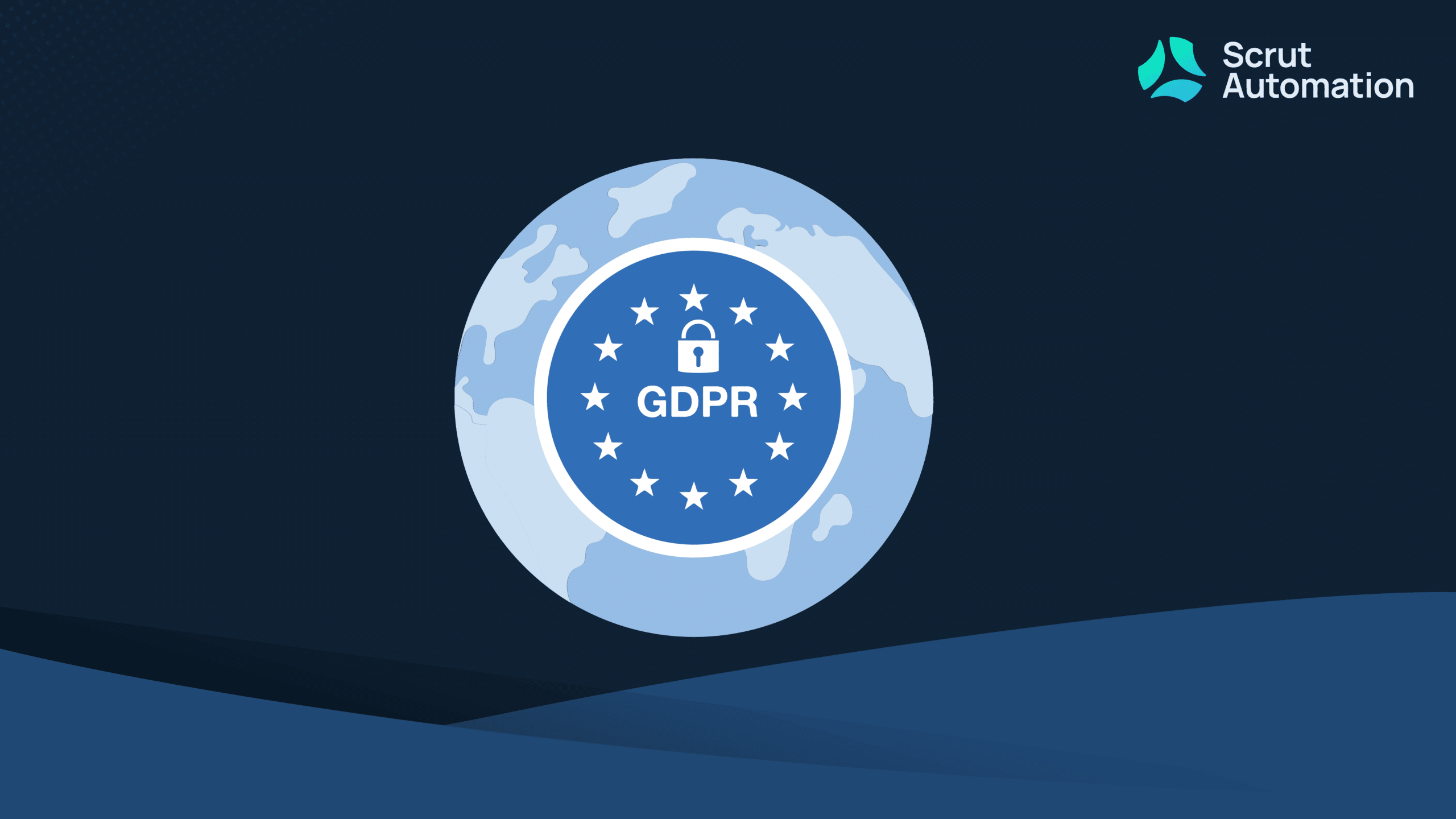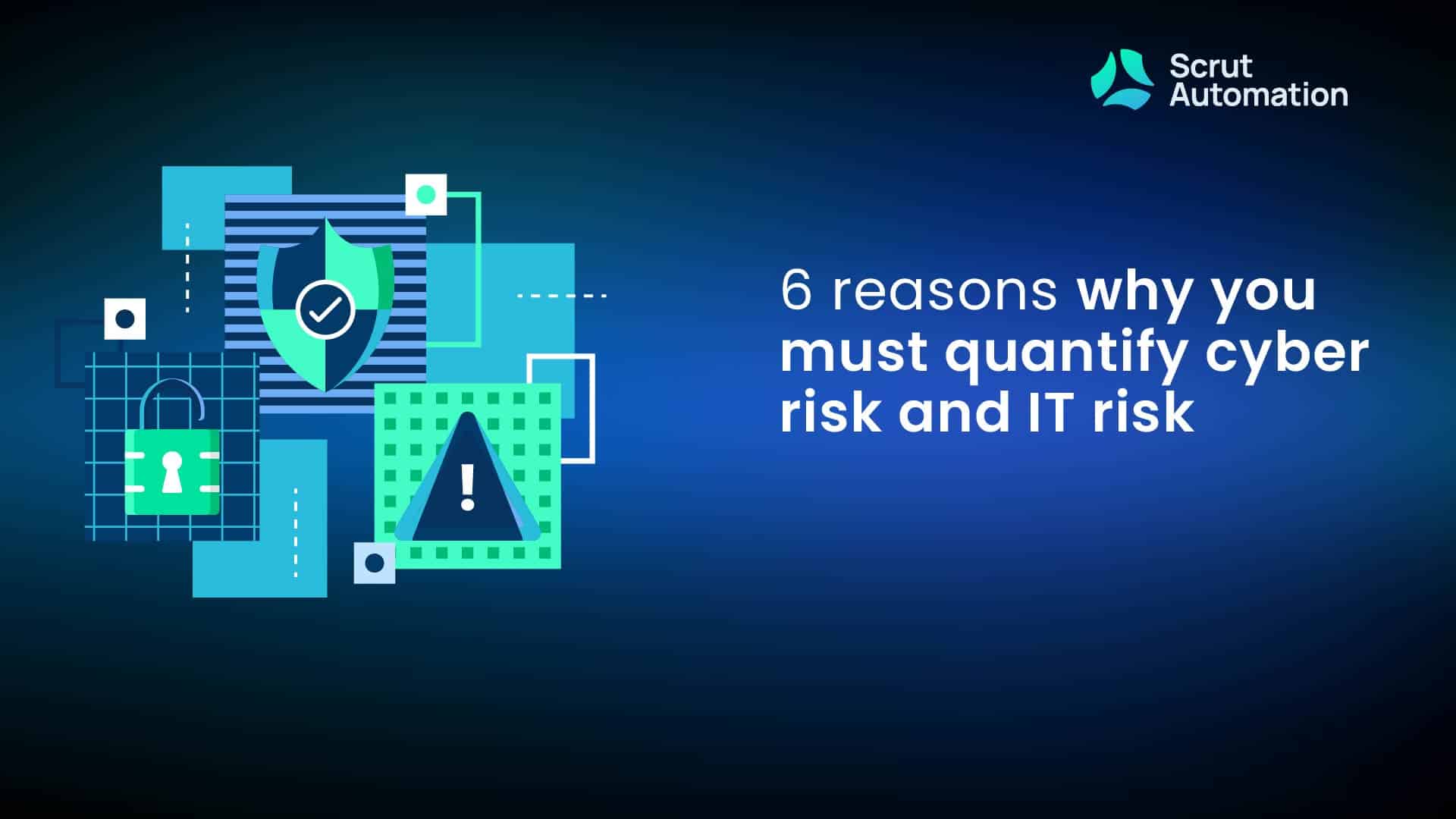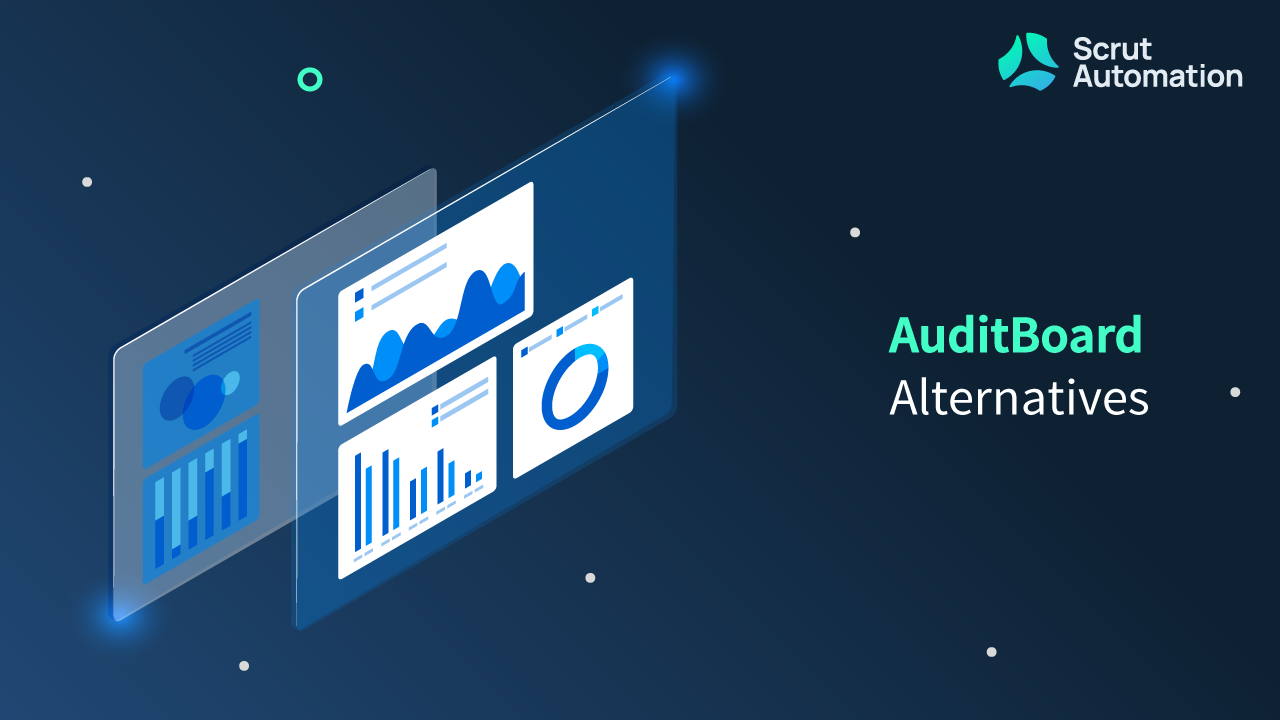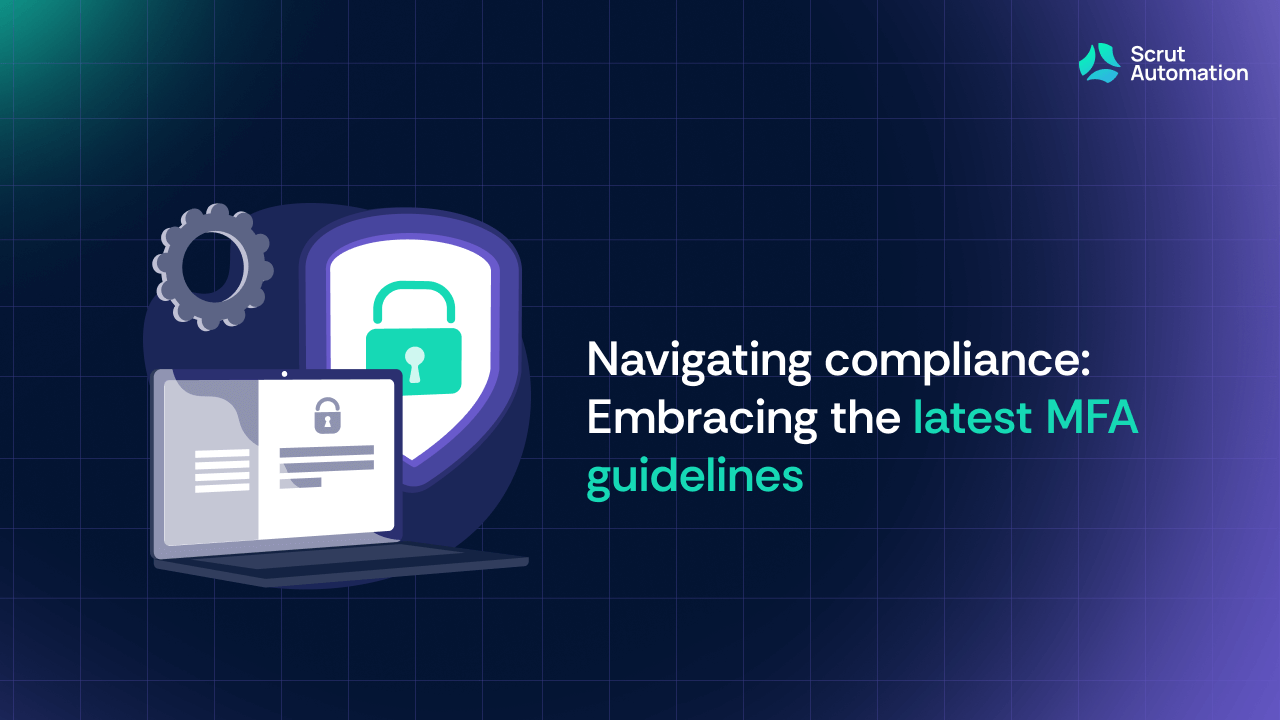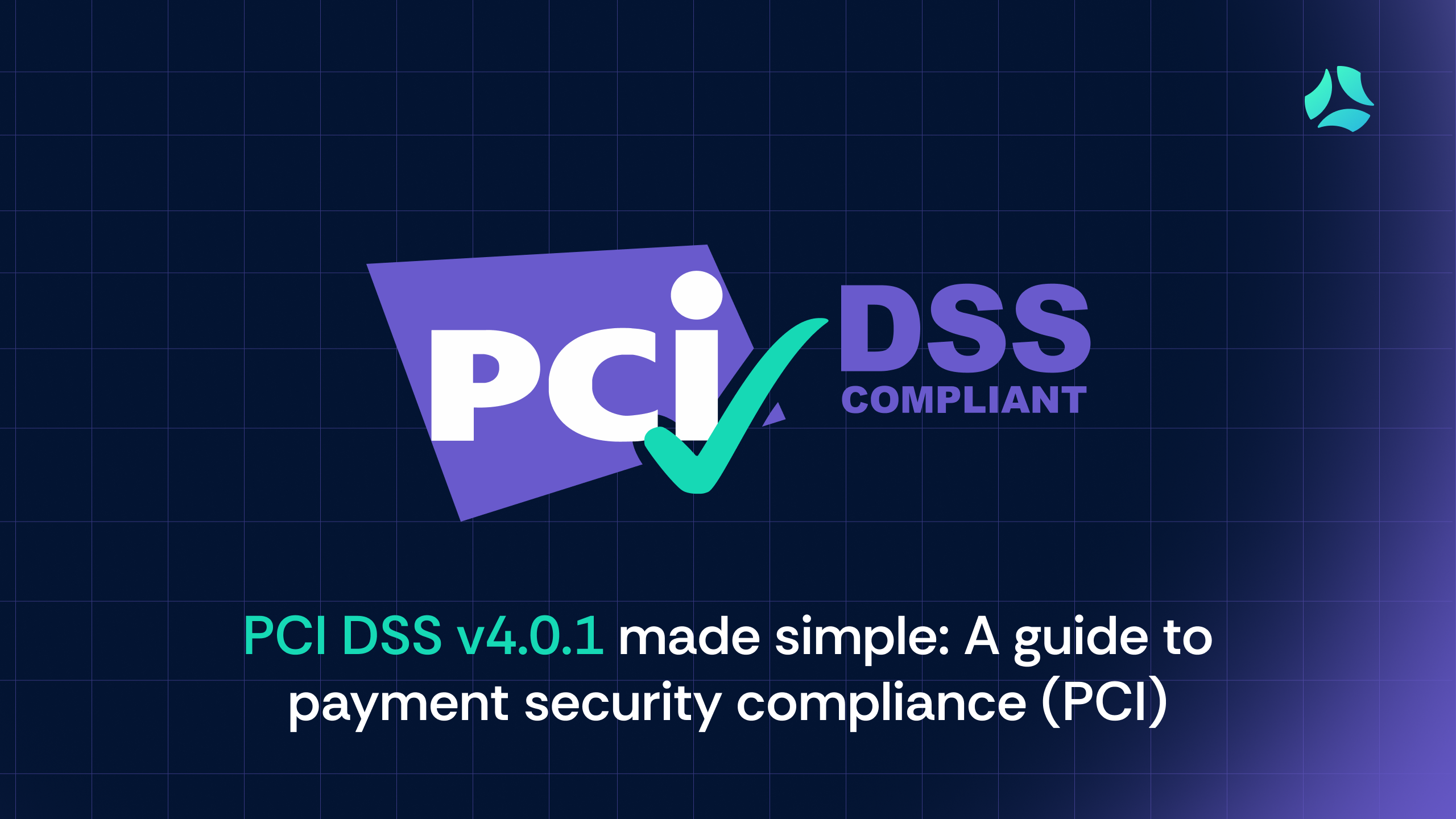Artificial intelligence (AI) risk management holds significant importance in the cybersecurity and compliance landscape. With the growing adoption of AI by cybercriminals, organizations need to stay vigilant.
AI aids real-time anomaly and intrusion detection, but its rollout requires careful management to prevent vulnerabilities. Compliance with regulations like GDPR or HIPAA is crucial, necessitating proper data handling by AI systems. Addressing ethical issues such as bias and privacy is essential. Organizations must also assess supply chain risks linked to AI components and prioritize data security. Maintaining accountability in AI risk management is vital to exhibiting due diligence and fulfilling legal obligations. In essence, effective AI risk management protects against emerging threats, ensures compliance, and reduces potential risks. And there was a wide gap in formalizing effective AI risk management.
NIST has developed an AI Risk Management Framework (RMF) as a structured approach to assess, manage, and mitigate risks associated with AI technologies. This framework provides guidelines and procedures for organizations to systematically identify, evaluate, and address AI-related risks in their operations, enhancing the security and reliability of AI systems.
What is NIST?
The National Institute of Standards and Technology (NIST) is a U.S. federal agency within the Department of Commerce. NIST develops and promotes measurement, standards, and technology to enhance productivity, facilitate trade, and improve the quality of life. NIST is well-known for its work in setting standards in areas such as cybersecurity, information technology, engineering, and physical sciences. It plays a crucial role in advancing technology and ensuring its reliability and security.
What are the functions of NIST?

Here’s an overview of NIST’s key functions and activities:
1. Standards development
NIST develops and maintains measurement standards, guidelines, and best practices in various fields, including engineering, manufacturing, cybersecurity, information technology, and more. These standards are essential for ensuring quality, reliability, and interoperability across industries.
2. Research and innovation
NIST conducts research in areas such as physics, materials science, and information technology. This research often leads to technological advancements that benefit both industry and society.
3. Metrology
NIST is responsible for maintaining and disseminating measurement standards, including those related to units of measurement (e.g., the meter, kilogram, and second). This ensures accuracy and consistency in measurements used in scientific research and industry.
4. Cybersecurity
NIST is a leader in developing cybersecurity standards and guidelines for both government agencies and private-sector organizations. The NIST Cybersecurity Framework, for example, is widely used to improve cybersecurity posture.
5. Information technology
NIST provides guidance on IT security, software testing, and data encryption. It also conducts research in emerging areas of technology like quantum computing.
6. Manufacturing and industry
NIST supports U.S. manufacturing through programs aimed at improving product quality, manufacturing processes, and supply chain resilience.
7. Innovation and entrepreneurship
NIST fosters innovation and entrepreneurship by providing resources, technology transfer programs, and research collaborations to help businesses develop and commercialize new technologies.
8. Publications and resources
NIST publishes a wealth of information, including research papers, guidelines, and handbooks, which are widely used by researchers, industry professionals, and policymakers.
9. Collaboration
NIST collaborates with industry, academia, and other government agencies to address complex scientific and technological challenges. It also provides testing and calibration services to support various industries.
NIST’s role in shaping cybersecurity standards

NIST, the National Institute of Standards and Technology, plays a pivotal role in shaping cybersecurity standards through its comprehensive approach to cybersecurity guidance and development. Here’s an overview of NIST’s role:
1. NIST Cybersecurity Framework (CSF):
NIST developed the CSF, a widely adopted framework providing structured guidance for organizations to manage and enhance their cybersecurity posture. It encompasses guidelines, standards, and best practices, facilitating the identification, protection against, detection, response to, and recovery from cyber threats.
2. Special Publications (SPs):
NIST publishes a series of Special Publications covering various cybersecurity aspects, such as risk management, encryption, and incident response. These documents serve as authoritative references for organizations and government agencies, providing detailed guidance on cybersecurity practices.
3. Federal Information Processing Standards (FIPS):
NIST issues FIPS, which are mandatory standards for federal agencies and often influence cybersecurity practices in the private sector. These standards define requirements for various aspects of information security, including cryptographic algorithms and key management.
4. National Cybersecurity Center of Excellence (NCCoE):
NIST’s NCCoE collaborates with industry, academia, and government agencies to develop practical, standards-based cybersecurity solutions. It produces reference architectures and implementation guides that organizations can use to enhance their security measures.
5. Continual Research:
NIST conducts ongoing research on emerging technologies, such as quantum computing and post-quantum cryptography, to inform the development of new standards and guidance addressing evolving threats.
6. Public-Private Collaboration:
NIST fosters collaboration between cybersecurity professionals, industry stakeholders, and government agencies during the development of cybersecurity standards and guidelines. This collaborative approach ensures that standards are rigorous, practical, and widely accepted.
7. Global Influence:
NIST’s cybersecurity standards serve as models for international standards bodies and contribute to the development of global cybersecurity practices. This promotes consistency and interoperability in the global cybersecurity landscape.
8. Responsiveness to Emerging Threats:
NIST remains responsive to emerging threats by swiftly adapting its guidance to address new risks and vulnerabilities. Its dedication to cybersecurity standards and best practices benefits both government and private-sector organizations, providing a structured and adaptable framework for enhancing cybersecurity practices and mitigating risks.
The need for AI risk management

AI risk management is imperative for various reasons.
1. Tools for Cyber Criminals
With AI technology advancing, it has become a tool for cybercriminals to launch sophisticated attacks, necessitating the management of AI-related security risks. AI relies on large datasets, often containing sensitive information, making it essential to protect data privacy and adhere to regulations like GDPR and HIPAA.
2. Ethical Concerns and Bias Mitigation
AI models can inherit biases from their training data, resulting in unfair or discriminatory outcomes. Effective risk management is needed to address these ethical concerns. Many industries are subject to stringent regulations, and AI risk management is crucial to prevent legal and financial penalties.
3. Supply Chain Vulnerabilities
Organizations often source AI components from third-party vendors, introducing supply chain vulnerabilities that must be managed to avoid potential breaches. Additionally, automated AI systems can unintentionally introduce security vulnerabilities if not properly managed, highlighting the importance of risk management to ensure that automation enhances security.
4. Accountability and Due Diligence
Accountability is another critical aspect, as organizations must demonstrate due diligence in managing AI risks, including maintaining proper documentation to meet legal and regulatory requirements. Given that AI models heavily rely on data, robust data security measures are necessary to protect data confidentiality and integrity.
5. Regulatory Compliance
Many industries are subject to stringent regulations, necessitating AI risk management to prevent legal and financial penalties associated with non-compliance.
The unique challenges AI systems pose in terms of cybersecurity
AI systems present unique challenges in the realm of cybersecurity due to their growing prevalence and capabilities. These challenges arise from the complex nature of AI technology, its reliance on vast datasets, and the potential for misuse by cyber criminals. Understanding these challenges is crucial for organizations and cybersecurity professionals to develop effective strategies for protecting AI systems and the data they handle.

AI systems introduce several unique challenges in terms of cybersecurity:
- Sophisticated attacks: AI can be used by cybercriminals to conduct more sophisticated and targeted attacks. AI-driven malware can adapt to defenses in real time, making them harder to detect and combat.
- Adversarial attacks: AI models, including machine learning and deep learning algorithms, can be tricked or manipulated through adversarial attacks. Attackers can subtly modify inputs to fool AI systems into making incorrect decisions or classifications.
- Data privacy risks: AI systems rely on vast amounts of data for training and operation. Protecting this data from unauthorized access, leaks, or breaches is a significant challenge, particularly when dealing with sensitive or personal information.
- Bias and fairness: AI models may inherit biases from their training data, resulting in unfair or discriminatory outcomes. Addressing bias and ensuring fairness in AI systems while maintaining security is a complex challenge.
- Explainability and transparency: Many AI algorithms, such as deep neural networks, can be highly complex and difficult to interpret. This lack of explainability makes it challenging to understand how AI systems arrive at their decisions, which can be a security concern when trying to identify and rectify vulnerabilities or biases.
- Supply chain vulnerabilities: Organizations often source AI components or services from third-party vendors. These dependencies can introduce security risks, as vulnerabilities in the supply chain can be exploited to compromise AI systems.
- Automation risks: Automated AI systems can inadvertently introduce security vulnerabilities or misbehave if not designed, trained, or managed correctly. Ensuring that automation enhances security rather than undermining it is a critical challenge.
- Scale and complexity: AI systems can be deployed at a large scale, making it challenging to monitor and secure all aspects of the AI infrastructure, from data pipelines to the deployment of AI models.
- Lack of standards: The rapid development and adoption of AI have outpaced the establishment of comprehensive cybersecurity standards and best practices. This creates a need for evolving and adapting security measures in the AI context.
- Zero-day vulnerabilities: AI systems may be susceptible to zero-day vulnerabilities that attackers can exploit before security patches or countermeasures can be developed and deployed.
- Misuse of AI for cyberattacks: Beyond exploiting AI vulnerabilities, attackers can misuse AI for malicious purposes, such as generating convincing deepfake content, automating phishing campaigns, or weaponizing AI for reconnaissance and decision-making in attacks.
Addressing these challenges requires a multidisciplinary approach that combines expertise in AI, cybersecurity, data privacy, ethics, and compliance. Organizations must continually adapt their cybersecurity strategies to keep pace with the evolving landscape of AI-related threats and vulnerabilities.
Key principles of NIST’s AI RMF
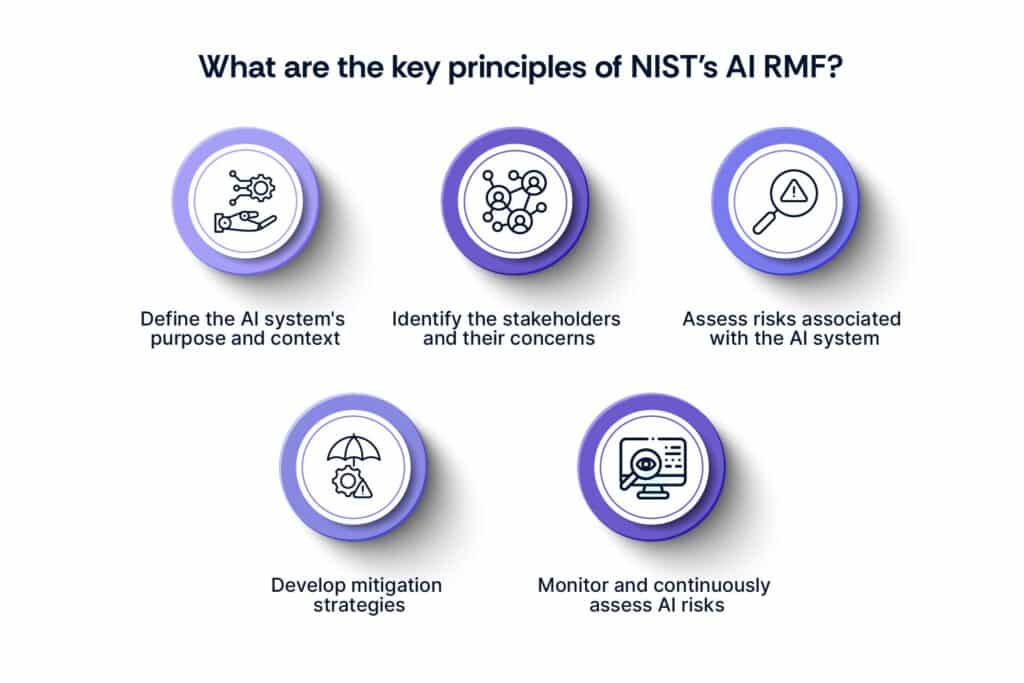
AI RMF defines key principles and core functions for managing the risks associated with AI systems. Here are the key principles of NIST’s AI RMF:
1. Define the AI system’s purpose and context
Defining the purpose and context of an AI system is a fundamental step in leveraging artificial intelligence effectively. Organizations must articulate the specific objectives and goals they aim to achieve with the AI system. This clarity helps align the technology with the broader strategic vision.
Furthermore, understanding the context in which the AI system operates is equally crucial. This involves comprehending how the AI system fits into the organization’s existing business processes, workflows, and infrastructure. It also entails recognizing its interactions with other systems, databases, and data sources. This contextual awareness is vital for seamless integration and efficient functioning within the organizational ecosystem.
2. Identify the stakeholders and their concerns
Identifying stakeholders and understanding their concerns is crucial for effective AI system management. This involves recognizing all individuals or groups directly involved with or influenced by the AI system, including users, customers, regulatory bodies, and internal teams.
Understanding the unique concerns, expectations, and requirements of each stakeholder group is essential. Users prioritize usability and functionality; customers seek enhanced services, regulatory bodies emphasize compliance, and internal teams focus on operational efficiency and resource allocation.
Comprehending these diverse concerns helps align the AI system’s development and deployment with organizational goals. It also facilitates compliance with regulatory frameworks, ensuring ethical and legal operation. Ultimately, understanding stakeholders fosters trust, enables successful AI adoption, and yields positive outcomes for all parties involved.
3. Assess risks associated with the AI system
Assessing risks associated with an AI system is a critical step in ensuring its responsible and effective deployment. To begin, organizations should conduct a thorough risk assessment, identifying potential threats and vulnerabilities that the AI system might encounter during its lifecycle. This comprehensive evaluation extends beyond technical aspects and includes non-technical factors such as data privacy, security, and ethical considerations.
Once potential risks are identified, it’s essential to evaluate their impact, not only on the AI system itself but also on the organization as a whole. Assessing how these risks can affect business processes, data integrity, compliance with regulations, and reputation is crucial for making informed decisions.
This multifaceted approach to risk assessment helps organizations proactively address and mitigate potential issues, fostering a responsible and secure AI environment. By combining technical scrutiny with ethical and operational considerations, organizations can better navigate the complex landscape of AI risks, ultimately leading to more successful AI implementations.
4. Develop mitigation strategies
Developing mitigation strategies is a crucial aspect of ensuring the trustworthiness of AI systems. Once organizations identify potential risks associated with their AI systems, they should actively work on formulating strategies to mitigate or reduce these risks. These strategies encompass various approaches, each tailored to address specific concerns.
One common mitigation approach involves implementing robust security measures to safeguard AI systems from unauthorized access, data breaches, and cyber threats. Ensuring the integrity and confidentiality of data is essential for maintaining trust in AI applications.
Data anonymization is another strategy that helps protect individuals’ privacy by removing personally identifiable information from datasets used for AI training and inference. By anonymizing data, organizations can reduce the risk of privacy violations and data misuse.
Ethical considerations are paramount in AI development, and incorporating ethical guidelines into the system’s design is an essential mitigation strategy. Ethical guidelines can help organizations navigate potential biases, discrimination, and other ethical dilemmas, ultimately fostering trust among users and stakeholders.
5. Monitor and continuously assess AI risks
Monitoring and assessing AI risks continuously is essential for responsible AI governance. Risk management should be ongoing, not a one-time task. To ensure trustworthy AI systems, organizations should:
- Establish Continuous Monitoring Mechanisms: Implement real-time or periodic monitoring of AI performance, data inputs, and outcomes to detect deviations early.
- Regularly Assess Mitigation Strategies: Evaluate the effectiveness of mitigation strategies to address identified risks. Adjust and improve strategies as needed for better risk management.
- Stay Informed about Emerging Risks: Keep abreast of technological advancements, regulatory changes, and emerging risks in the dynamic AI landscape. Adapt risk management strategies accordingly.
What are the steps to implement NIST’s AI RMF?
Let’s delve into the NIST’s AI Risk Management Framework in detail, including the steps and recommended practices for each:
Step 1: Define the AI system’s purpose and context
In this initial step, organizations should clearly articulate the intended purpose of the AI system. It involves understanding how the AI system fits into the organization’s overall goals and operations. Context includes its role in business processes and interactions with other systems or data sources.
Best practices:
- Engage with stakeholders to gather input on the system’s purpose and context.
- Document the objectives and expected outcomes of the AI system.
- Ensure alignment with organizational goals and regulatory requirements.
Step 2: Identify stakeholders and concerns
Recognizing all stakeholders involved in or affected by the AI system is crucial. Stakeholders may include users, customers, regulatory bodies, internal teams, or external partners. Understanding their concerns, expectations, and requirements helps align the AI system with organizational goals and regulatory compliance.
Best practices:
- Conduct comprehensive stakeholder analysis to identify all parties involved.
- Prioritize concerns and expectations based on stakeholder impact.
- Establish communication channels to address stakeholder concerns effectively.
Step 3: Assess AI risks
In this step, organizations conduct a comprehensive risk assessment to identify potential threats and vulnerabilities associated with the AI system. This assessment involves analyzing both technical and non-technical aspects, including data privacy, security, and ethical considerations.
Best practices:
- Utilize risk assessment frameworks and methodologies.
- Consider both internal and external risks.
- Evaluate the likelihood and potential impact of identified risks.
Step 4: Develop mitigation strategies
Once risks are identified, organizations should formulate strategies to mitigate or reduce these risks. Mitigation strategies may involve implementing security measures, data anonymization, or incorporating ethical guidelines into the AI system’s design.
Best practices:
- Create a risk mitigation plan with specific actions and responsible parties.
- Consider a combination of technical and non-technical controls.
- Continuously assess the effectiveness of mitigation measures.
Step 5: Monitor and continuously assess AI risks
Risk management is an ongoing process. Organizations should establish mechanisms for continuous monitoring of the AI system. Regularly assess the effectiveness of mitigation strategies and adapt them as needed. Stay informed about emerging risks, technological advancements, and regulatory changes that may impact the AI system.
Best practices:
- Implement real-time monitoring and reporting mechanisms.
- Conduct periodic risk assessments to account for changes in the AI system’s environment.
- Stay updated on AI industry trends and evolving risks.
Benefits of NIST’s AI RMF
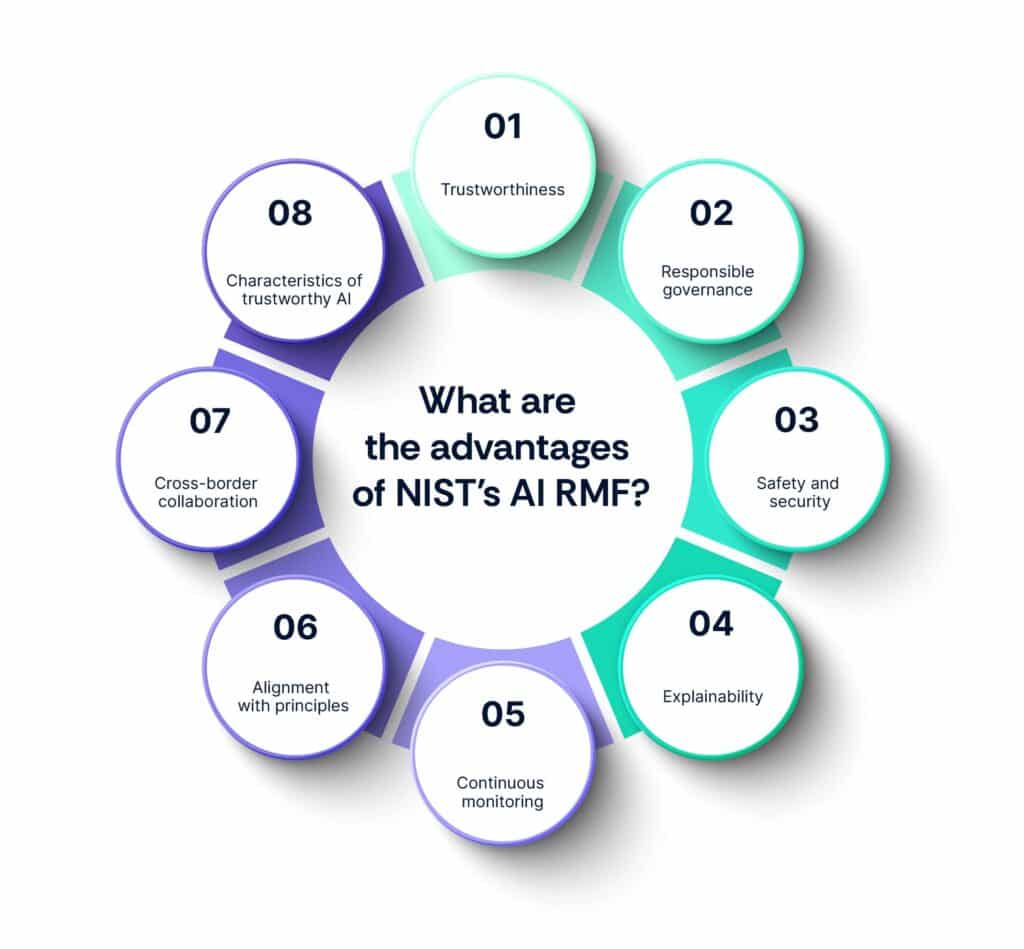
NIST’s AI RMF plays a crucial role in achieving responsible AI development by offering several benefits:
1. Trustworthiness
AI RMF focuses on incorporating trustworthiness considerations into AI systems. This ensures that AI technologies are developed and deployed in a manner that can be trusted by users, organizations, and society at large.
2. Responsible governance
The framework provides a structured approach to managing AI risks, fostering responsible governance. It encourages organizations to follow ethical guidelines, legal compliance, and best practices throughout the AI lifecycle.
3. Safety and security
AI RMF emphasizes the safety, security, and resilience of AI systems. It helps organizations identify potential vulnerabilities and threats, leading to the development of AI systems that are less prone to errors, misuse, or malicious attacks.
4. Explainability
Responsible AI development includes the ability to explain AI decisions. AI RMF encourages organizations to make AI systems explainable, ensuring that users can understand the reasoning behind AI-generated outcomes.
5. Continuous monitoring
The framework promotes continuous monitoring and assessment of AI risks. This proactive approach enables organizations to adapt to evolving threats and challenges, reducing the potential for negative consequences.
6. Alignment with principles
AI RMF aligns with key AI principles, such as fairness, transparency, and accountability. It ensures that responsible AI development principles are integrated into every stage of AI system development.
7. Cross-border collaboration
By providing a trusted and adaptable framework, AI RMF encourages cross-border collaboration. This is essential in today’s globalized world, where AI technologies transcend geographical boundaries.
8. Characteristics of trustworthy AI
AI RMF identifies characteristics of trustworthy AI, which include safety, security, resilience, and explainability. Organizations can use these characteristics as benchmarks for responsible AI development.
What is Scrut’s role in NIST AI RMF?
Scrut plays a significant role in implementing the NIST AI RMF, which aims to minimize negative impacts and maximize positive outcomes of AI systems. It integrates top AI principles, helping organizations adhere to the framework and establish a new standard for excellence in AI governance. Scrut’s automation capabilities enable organizations to implement the AI RMF efficiently, ensuring responsible AI development and compliance with ethical standards and legal requirements. Additionally, Scrut assists organizations in utilizing the GOVERN function of the AI RMF, focusing on securely and responsibly using AI technologies.
Conclusion
In conclusion, AI risk management is crucial in today’s fast-paced technological landscape. As organizations adopt AI, they face diverse risks like cyber threats, data privacy, ethics, and supply chain vulnerabilities. NIST’s AI Risk Management Framework (AI RMF) offers a structured approach to identify, assess, and mitigate these risks. Following NIST’s guidelines ensures responsible AI development aligned with ethical standards and legal requirements.
Proactive AI risk management is essential to safeguard individuals and organizations while fostering innovation. Embracing NIST’s AI RMF and its principles enables organizations to navigate the AI landscape confidently, ensuring positive outcomes in our interconnected world.
Take control of your AI risk management with Scrut, and implement NIST’s AI RMF effectively. Safeguard your AI systems, ensure compliance, and promote responsible AI development. Get started today!
FAQs
AI risk management involves identifying, assessing, and mitigating potential risks associated with artificial intelligence systems. It’s crucial because AI is becoming a tool for cybercriminals, and organizations must protect against evolving threats, ensure compliance, and prevent potential harm.
NIST, the National Institute of Standards and Technology, provides a structured framework called the AI Risk Management Framework (AI RMF). It offers guidelines and procedures to help organizations systematically manage and mitigate AI-related risks, ensuring the security and reliability of AI systems.
NIST’s framework emphasizes trustworthiness by integrating ethical standards, legal compliance, and best practices into every stage of AI system development. It fosters responsible AI governance, safety, security, explainability, and continuous monitoring.

